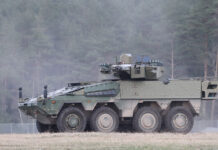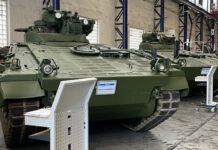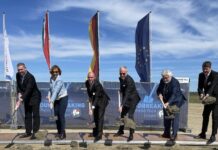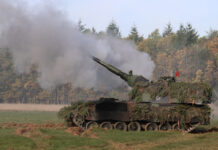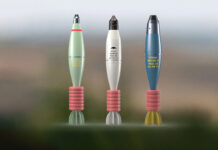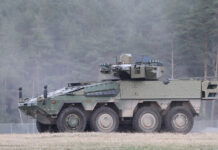In view of the war in Ukraine and the associated reorientation of many armed forces towards national and alliance defence, the weapon systems required for this purpose, such as mortars, automatically become the object of modernisation efforts by the armed forces.
As expected, the efforts initiated and planned to modernise mortar systems in the armed forces have driven some technological developments in European industry, some of which were recently presented at the DSEI international defence exhibition in London.
EXPAL
EXPAL, a Spanish one stop shop for mortar systems, introduced eCompaX, an electronic aiming device for dismounted mortar systems of all calibres. The eCompaX weighs approx. 1.2 kg and measures 175x75x65 mm.
Designed to replace conventional sight units, eCompax simplifies and accelerates the setup and aiming of dismounted mortars. The system has several GPS-independent sensors, including a camera, an inertial measurement unit (IMU) and a magnetic compass, which provide north finding and, consequently, data on the vertical and horizontal alignment regarding to all types of norths (magnetic, true and grid) of the mortar. According to the company, the mortar can be aligned with the target within 30 seconds.

At DSEI, EXPAL demonstrated that the system is very easy to operate. After reaching the firing position, eCompax is placed with the camera forward in the rough firing direction a few metres away in front of the mortar. The integrated north finder is to determine the magnetic north direction within approx. ten seconds to an accuracy of up to seven mils. The camera then shoots a series of images to optically “fix” the magnetically determined north direction. The images then serve as a guideline for the determination of the position of the weapon system, following which eCompax will be attached to the periscope mount on the bipod. Pictures are also taken here. An algorithm calculates the lateral alignment of the weapon system on the basis of the image comparison; the IMU determines the elevation.
In addition, the company presented M-Counter, an electronic shot counter for mortars. M-Counter works independently of energy sources and is to relieve mortar troops of documentation tasks and simplify maintenance planning through automatic data acquisition.
Hirtenberger
Hirtenberger Defence Europe exhibited the 120mm Super Rapid Advanced Mortar System MKII (SRAMS MKII) at DSEI. At Eurosatory 2018, Hirtenberger had announced a cooperation with ST Engineering under which Hirtenberger would market the automatic mortars of the SRAMS family in Europe. In mid-November, the new system will be presented to a European expert audience in Slovakia for the first time. The original 120mm SRAMS had a hydraulic elevation and traverse, while the new SRAMS Mk II features a fully electric vertical and lateral adjustment, the latter being increased to 180 degrees on both sides.
There was also some news on the business side of Hirtenberger. The company received an order in the first half of 2019 to supply insensitive 60mm mortar ammunition to the Dutch armed forces. The framework agreement has a term of five years with the option of extending it by a further two years.
Rheinmetall
At the German Infantry Day in Hammelburg in July 2019, Rheinmetall presented the RSG60 60mm mortar for the first time. The innovative design of the weapon system saves space and enables users to prepare the mortar for fire in just a few seconds from the transport position. By loosening the retaining bolts, it is possible to separate the RSG60 from the base plate in around thirty seconds, transforming it into a light-weight commando mortar.

The current version of the RSG60 could be seen at DSEI; it differs from the pictures released earlier which showed a demonstrator. In the current version, the handle and the base plate have been designed more ergonomically. In addition, a simple aiming device based on a compass and known as a “Quickshot aiming device” was displayed.
The RSG60 development team said that the heat management of the mortar is not significantly affected by the composite construction of the new tube. Physically, lighter tubes heat up faster but cool down faster than regular tubes. The RSG60 tube has another handy feature. The thread at the end of the tube can be used to attach a tube extension. This can result in range advantages. In addition to the tube extension, Rheinmetall has also developed a prototype silencer that can be screwed onto the thread. The silencer`s performance is just under 10 dB, which corresponds to a reduction in volume of almost 50%.
At DSEI, Rheinmetall unveiled the RAGNAROK (MWS120) automated 120mm mortar weapon system for the first time. The manually loaded and fully electric system with mechanical transmission enables a firing rate of 16-20 rounds per minute. With a weight of just under one tonne and, according to the company’s figures, a significantly lower recoil than comparable competitive systems, RAGNAROK can also be integrated with light 4×4 platforms with the use of support legs without unduly impairing the vehicle’s chassis structure.
According to the product manager, the development of the RAGNAROK was aimed at the highest possible fire rate and modularity at the lowest possible price. For this reason, they decided against an autoloader and designed the system so that almost any 120mm tube used could be reused inside the RAGNAROK. The tube can be removed by the mortar crew and, if necessary, used with a base plate and a bipod as a regular dismounted mortar. In addition, the MWS120 is optionally available without an independent fire control system to enable further use of existing systems.
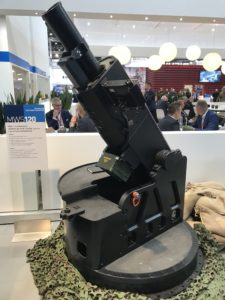
The modularity of the RAGNAROK offers several advantages. If necessary, costs for the purchase and training of a new system can be saved by continuing to use existing systems. In addition, it basically offers customers the opportunity to configure their own mortar. Depending on requirements and available budget, all individual systems can be combined by a single supplier or by different suppliers to form a complete mortar system (fully automatic weapon system with fire control system). A further advantage is that the components of the mortar can be individually modernised without having to redevelop the entire system. The introduction of new technologies and products can thus take place much more quickly and easily during the operating phase.
Conclusion
The comparably simple and robust functionality of the mortar allows it to be used in all types of military applications. The mortar is and remains an important tool for military commanders in combat, especially when the mortar systems introduced by the armed forces are upgraded to the state of the art.
Waldemar Geiger




